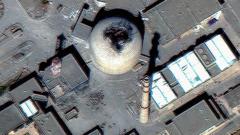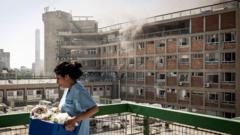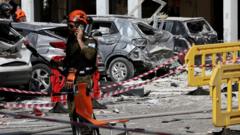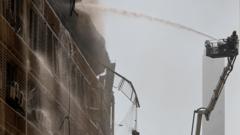Israeli military operations have significantly focused on Iran's nuclear facilities, leading to extensive destruction and casualties as the conflict escalates dangerously.
**Escalating Tensions: Israel Targets Iranian Nuclear Reactor Amid Ongoing Conflict**

**Escalating Tensions: Israel Targets Iranian Nuclear Reactor Amid Ongoing Conflict**
Israeli airstrikes have intensified against Iran, specifically targeting an unfinished nuclear reactor, amid rising tensions in the region.
Israel has escalated its military operations against Iran, striking an unfinished nuclear reactor known as the Arak heavy water reactor amid a broader campaign of airstrikes. The Israeli military announced the attack on the facility, claiming the aim was to prevent Iran from potentially developing nuclear weapons, despite Tehran’s assertions that its nuclear program is peaceful.
The International Atomic Energy Agency (IAEA) confirmed the reactor was attacked and noted that it did not contain any nuclear material at the time. The reactor, located approximately 250 kilometers southwest of Tehran, was designed to produce heavy water, which can lead to plutonium production, a critical ingredient for nuclear arms if enriched accordingly.
Prior to the recent airstrikes, Iran had reportedly transformed the Arak reactor’s calandria, effectively rendering it inoperable under a 2015 agreement with world powers aimed at curtailing Tehran’s nuclear ambitions. Minor construction work had resumed at Arak, with expectations for commissioning in 2023 and operational capacity in 2026.
The Israeli defense forces indicated that the strike deliberately aimed at components intended for producing plutonium to hinder the facility from becoming functional. In footage released by the Israeli military, significant explosions were observed at the reactor site, which is highlighted by a conspicuous hole visible in satellite imagery.
Iranian state television, however, portrayed the government's preparedness by asserting that precautions had been implemented to safeguard the facility, claiming no contamination arose from the attack. Reports also indicated that additional Israeli strikes targeted another critical site at Natanz, known for its production of enriched uranium that could lead to nuclear weapons development if further refined.
The situation has escalated into heightened hostilities, with both nations experiencing significant casualties amid these conflict escalations. Reports indicate that hundreds of people, including military personnel, have died either as a result of airstrikes or retaliatory ballistic missile attacks. As the situation develops, international observers remain concerned about the implications of these military actions on regional stability and global non-proliferation efforts.
The International Atomic Energy Agency (IAEA) confirmed the reactor was attacked and noted that it did not contain any nuclear material at the time. The reactor, located approximately 250 kilometers southwest of Tehran, was designed to produce heavy water, which can lead to plutonium production, a critical ingredient for nuclear arms if enriched accordingly.
Prior to the recent airstrikes, Iran had reportedly transformed the Arak reactor’s calandria, effectively rendering it inoperable under a 2015 agreement with world powers aimed at curtailing Tehran’s nuclear ambitions. Minor construction work had resumed at Arak, with expectations for commissioning in 2023 and operational capacity in 2026.
The Israeli defense forces indicated that the strike deliberately aimed at components intended for producing plutonium to hinder the facility from becoming functional. In footage released by the Israeli military, significant explosions were observed at the reactor site, which is highlighted by a conspicuous hole visible in satellite imagery.
Iranian state television, however, portrayed the government's preparedness by asserting that precautions had been implemented to safeguard the facility, claiming no contamination arose from the attack. Reports also indicated that additional Israeli strikes targeted another critical site at Natanz, known for its production of enriched uranium that could lead to nuclear weapons development if further refined.
The situation has escalated into heightened hostilities, with both nations experiencing significant casualties amid these conflict escalations. Reports indicate that hundreds of people, including military personnel, have died either as a result of airstrikes or retaliatory ballistic missile attacks. As the situation develops, international observers remain concerned about the implications of these military actions on regional stability and global non-proliferation efforts.





















